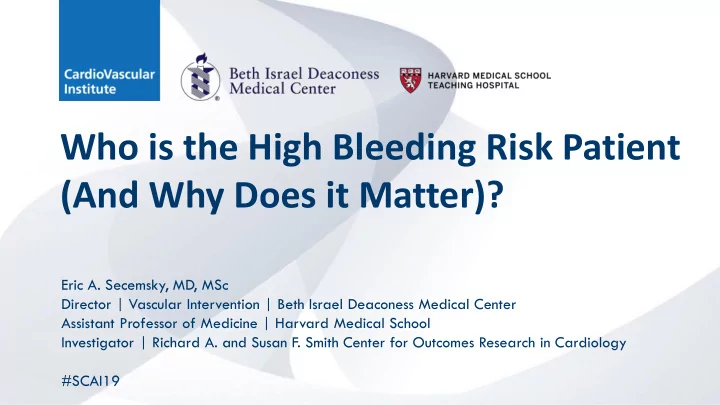

Who is the High Bleeding Risk Patient (And Why Does it Matter)? Eric A. Secemsky, MD, MSc Director | Vascular Intervention | Beth Israel Deaconess Medical Center Assistant Professor of Medicine | Harvard Medical School Investigator | Richard A. and Susan F. Smith Center for Outcomes Research in Cardiology #SCAI19
Disclosures Speaking/Consulting: Medtronic (Moderate)
How Big an Issue is Post-PCI Bleeding? ADAPT- DES: Prospective registry of 8,582 “all - comers” who underwent PCI with DES *6.2% had post-discharge bleeding within 2 years Genereaux, Giustino, et al. JACC 2015.
How Big an Issue is Post-PCI Bleeding? HMORN-Stent Registry: 8,137 pts who underwent PCI with DES at 3 large health systems *4.8% had bleeding-related hospitalization after discharge Valle, Shetterly, et al. Circ Cardiovasc Interv 2016.
What are the Risks of Post-PCI Bleeding? NCDR CathPCI Registry: 3,386,688 PCIs in US between 2004-2011, in-hospital bleeding *3.39% absolute risk increase of in-hospital death, NNH 29 Chhatriwalla, Amin, et al. JAMA 2013.
What are the Risks of Post-PCI Bleeding? 5,384 pts from 4 PCI RCTs of abciximab; bleeding events w/in 30 days; mortality at 1 yr *0.8% bleeding at 30 days Ndrepepa, Berger, et al. JACC 2008.
What are the Risks of Post-PCI Bleeding? 32,906 pts from Kaiser; adverse events 7-365 days post-PCI; median f/u 4.42 years Kazi, Leong, et al. JACC 2015.
What are the Risks of Post-PCI Bleeding? DAPT Study: 11,648 post-PCI pts wo bleeding/ischemia at 12 mos; events 12-33 mos Secemsky, Yeh, et al. JAMA Cardiology 2017.
How Do We Define High Bleeding Risk Bleeding eding Definition nition Matt tter ers Vranckx, White, et al. JACC 2016.
How Do We Define High Bleeding Risk Bleeding eding Definition nition Matt tter ers • TIMI major/minor only captured ~70% of BARC 3 bleeds • GUSTO moderate/ severe only captured ~80% of BARC 3 bleeds Vranckx, White, et al. JACC 2016.
How Do We Define High Bleeding Risk Academic Academic Resear search ch Conso sorti tium um - Hig igh h Bleeding eeding Ri Risk: sk: ≥4% risk of BARC 3 or 5 bleeding at 1 year OR ≥1% risk of an intracranial hemorrhage at 1 year Urban, Mehran, et al. In Press
How Do We Define High Bleeding Risk Academic Academic Resear search ch Conso sorti tium um - Hig igh h Bleeding eeding Ri Risk: sk: ≥4% risk of BARC 3 or 5 bleeding at 1 year OR ≥1% risk of an intracranial hemorrhage at 1 year Major or Crit iterion erion: independently confers a BARC 3 or 5 bleeding risk of ≥4% at 1 year or a risk of ICH of ≥1% at 1 year. Minor or Crit iter erion ion: independently confers an increased risk of bleeding, but <4% at 1 year. Urban, Mehran, et al. 2019. In Press
ARC Predictors of Bleeding Major Minor Age ≥75 years Long term oral anticoagulation* Severe or end-stage CKD (eGFR <30 ml/min) Moderate CKD (eGFR 30-59 ml/min) Hemoglobin <11 g/dL for both men and women Hemoglobin 11-12.9 g/dL for men and 11-11.9 g/dL for women Spontaneous bleeding requiring hospitalization and/or transfusion in the Spontaneous bleeding requiring hospitalization and/or transfusion within past 6 months or at any time if recurrent the past 12 months not meeting the major criterion Moderate or severe thrombocytopenia (platelet count <100 x 10 9 per liter) Chronic bleeding diathesis Liver cirrhosis with known or suspected portal hypertension Chronic use of oral NSAIDs or steroids Active malignancy‡ (excluding non -melanoma skin cancer) within the past 12 months Previous spontaneous ICH (at any time) Previous traumatic ICH within the past 12 months Any ischemic stroke at any time not meeting the major criterion Presence of a bAVM Moderate or severe ischemic stroke within the past 6 months Non-deferrable major surgery on DAPT Recent major surgery or major trauma within 30 days prior to PCI Urban, Mehran, et al. 2019. In Press
ARC Predictors of Bleeding Urban, Mehran, et al. 2019. In Press
How Do We Identify At-Risk Patients? REACH Dutch ASA score DAPT* PARIS PRECISE-DAPT BleeMACS Year of publication 2010 2014 2016 2016 2017 2018 Development dataset REACH registry Dutch ASA registry DAPT randomized PARIS registry Pooled analysis of 8 BleedMACS trial randomized trials registry Development dataset, n 56,616 235,531 11,648 4,190 14,963 15,401 Patient population Risk of New low-dose Stable and event-free Stable & unstable Stable and unstable ACS patients atherothrombosis† aspirin users pts 12 mos post-PCI pts undergoing PCI patients undergoing undergoing PCI PCI Bleeding outcome Serious bleeding at Upper GI bleeding Major bleeding Major bleeding at 2 Out-of-hospital Serious 2 years at a median follow- between 12 and 30 years bleeding at a median spontaneous up of 530 days months after PCI follow-up of 552 days bleeding at 1 year Bleeding definition used Protocol- defined‡ First episode of GUSTO moderate or BARC 3 or 5(13) TIMI major or Protocol-defined upper GI bleeding severe(144) minor(145,146) Proportion of HBR pts 25% (score >11) 83.1% (score >1) 23.4% (score -2 to 0) 8% (score >8) 25% (score ≥ 25) 25% (score >26) Rate of bleeding in the 2.76% (at 2 years) 2.7% (between 13 10.7% (at 2 years) 1.8-4.2% (at 1 year) 8.03% (at 1 year) 1% to 35% for HBR subgroup and 30 months) scores from 2 to 13 Also evaluates No No Yes Yes No No thrombotic risk Score range 0 to 23 0 to 15 -2 to 10 0 to 14 0 to 100 0 to 80 Development AUC 0.68 AUC 0.64 AUC 0.68 AUC 0.72 AUC 0.73 AUC 0.71 (0.72 in discrimination internal validation) Validating dataset CHARISMA Dutch health PROTECT ADAPT-DES PLATO and Bern PCI SWEDEHEART insurance database registry Validating dataset, n 15,603 32,613 8,136 8,130 8,595 and 6,172 96,239 (ACS+PCI) Validation AUC 0.64 AUC 0.63 AUC 0.64 (bleeding) AUC 0.64 AUC 0.70 and 0.66 AUC 0.65
Thank you! esecemsk@bidmc.harvard.edu @EricSecemskyMD Richard and Susan Smith Center for Outcomes Research in Cardiology 375 Longwood Avenue, 4 th Floor Boston, Massachusetts 02215
Recommend
More recommend